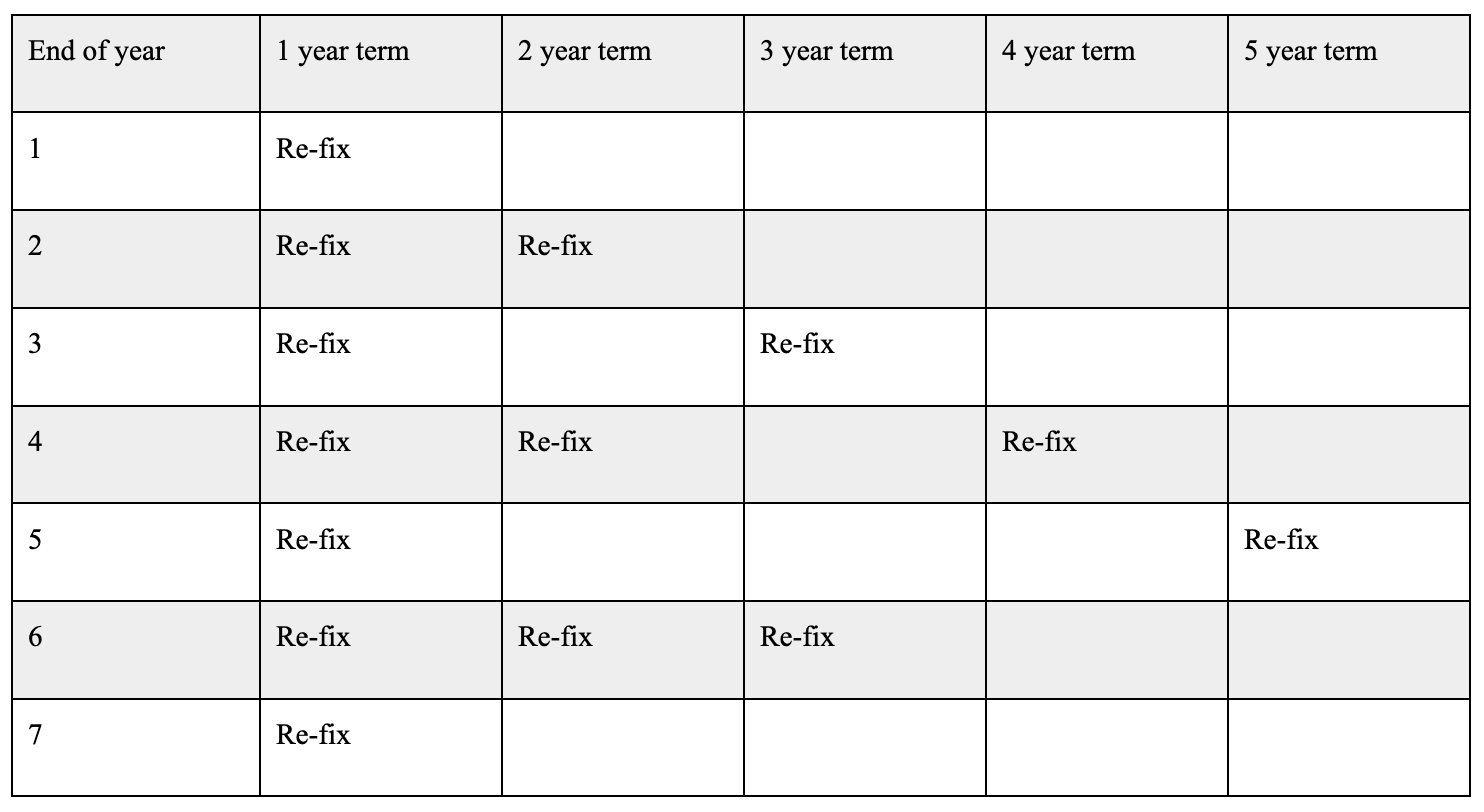Buying guide
Fixed, floating or split mortgage?
Understand your options
6 December 2023

Content provided by our partner mortgages.co.nz
If you’re about to buy a house, refinance an existing property or refix your home loan, strategy is really important. Your options of a fixed or floating mortgage, or a bit of both, require careful thought. More often than not, you’ll have a home loan professional to help, but it’s always smart to do some homework before you sit down with your adviser.
Basically, you can choose a fixed interest rate term (1 year, 2 years etc), a floating interest rate, or any combination of terms and types. You can also throw some different repayment structures into the mix, like an offsetting or revolving credit mortgage.
So let’s review some pros and cons of fixed and floating mortgages, then move on to examples of splitting a mortgage between them.
How does a fixed mortgage work?
As its name suggests, a fixed interest rate doesn’t change for an agreed term. You can usually choose six months, or one, two, three, four or five years. At the end of the term, you can re-fix on any new rate, or let it migrate (roll) onto the floating rate. The new rates will depend on what’s available at the time.
To provide a fixed rate mortgage, your lender usually borrows from investors or overseas wholesale lenders at a slightly lower fixed rate, often for the same interest rate period you agreed to. The lender protects their position by locking you in with a contract.
Advantages:
- The certainty of a fixed rate makes budgeting easier during the agreed term
- Fixed rates are usually lower than the floating rate at the time
- If interest rates rise, your fixed rate won’t rise during the agreed term
Disadvantages:
- Your ability to make extra repayments can be very limited or not available at all
- If you break the agreement during the fixed term, you may have to pay a penalty fee to cover the lender’s losses on relending the remaining balance – the fee can be substantial if you still have a large loan and market rates have since decreased
- When your term ends, interest rates could be much higher, creating a sudden increase in your repayments
- If interest rates fall, your fixed rate won’t fall during the agreed term
To learn more, see what is a fixed rate mortgage.
Choosing a fixed rate term
Choosing the best fixed rate term or combination of terms for you will often depend on:
- The rates you can afford
- The value you place on certainty, i.e. your risk appetite
- What you think interest rates could be like when each term ends
- Whether you might want to make a significant lump sum repayment during the next five years
- Whether you plan to sell your home or change lenders during the next five years
There may be some repayment flexibility with a fixed mortgage
Some lenders may let you increase your fixed rate mortgage repayments by a certain percentage (something like up to 20% of the minimum repayment required), without incurring early repayment penalties. Some may let you repay a lump sum of up to about $5,000 each year without penalty. If you’re selling to buy another home, you might be allowed to transfer a fixed mortgage to the new home to avoid early repayment penalties. These are all things you can ask about before choosing a lender.
How does a floating mortgage work?
A floating interest rate can increase or decrease at any time. As with any mortgage, you agree to repay the full amount by a certain date, such as 20 or 30 years after you take it out. This is known as the ‘mortgage term’ – don’t get it confused with an interest rate term.
Advantages:
- You can increase your repayments or pay off lump sums at any time without penalty
- If you’re ahead on your repayments you can usually reduce them back to the current minimum if you need to
- You can switch to a fixed rate or another lender at any time without paying a penalty to your current lender
- There’s more than one type of floating mortgage to choose from, such as offsetting or revolving credit home loans
- If the floating rate decreases you can choose to lower your repayments, or keep them the same and repay your mortgage faster
Disadvantages:
- Floating rates are usually higher than fixed rates at any time
- If the floating rate increases your repayments will increase, which might make budgeting difficult
To learn more, see what is a floating or variable rate mortgage.
Why do floating rates change?
The money you borrow from a floating mortgage provider sometimes comes from people and businesses who deposit money into an account. Your lender has to keep offering an interest rate that attracts and retains those deposits. But most of the money comes from overseas wholesale lenders and the Reserve Bank. What the wholesale lenders charge in interest is influenced by what they can get elsewhere in the world at the time. The Reserve Bank charges banks slightly more than the official cash rate (OCR). They set the OCR seven times a year to influence interest rates and, therefore, consumer spending and inflation. So while the OCR is often linked to floating interest rate changes, it’s only part of the story.
To learn more try our mortgage calculator and see how is mortgage interest calculated.
What are the different types of mortgages?
While the type of interest rate and the mortgage term will be part of your decision making when choosing a home loan, there are also different types of repayment structures to consider. Here’s a brief summary of the main ones.
Table mortgage: This is the most common type. Whether you choose a fixed or floating interest rate, your repayments remain the same until the interest rate changes. At first your repayments are mainly interest, but as you gradually repay what you owe (the principal) the interest component decreases and you pay back more principal each time.
Reducing mortgage: These are quite rare. You repay the same amount of principal each time, so the interest component steadily reduces. This means your initial repayments are quite high, but steadily decrease. It might be a good option if you’re heading into retirement.
Interest-only mortgage: With these you don’t repay any principal, you just keep paying interest on the full amount each time. Interest-only loans are usually available with a fixed or floating interest rate. They are an expensive option in the long term, but can suit some people who need to minimise costs initially. Interest-only loans have a maximum term of five years. At the end of the agreed term they must be repaid in full, which is usually done by refinancing with a new mortgage arrangement.
Offset mortgage: Only available on a floating rate, these allow you to use money in linked bank accounts to effectively reduce (offset) the amount you owe and, therefore, the interest you pay each time. Used wisely, they can save money and help you repay your mortgage faster, particularly if nearly all the principal in this type of mortgage is offset for most of each month.
Revolving credit mortgage: A bit like a giant overdraft, a revolving credit loan lets you repay (deposit) money and withdraw up to the set limit whenever you choose. You need to be really disciplined with money to make this work well. They’re also only available on a floating rate.
Reverse mortgage: If you’re over 60 and own your home outright, a reverse mortgage lets you borrow against your home and have no regular repayments at all. The (higher than normal) interest payments are added to your loan each month, so you start getting charged interest on the growing interest total, as well as on what you borrowed. When you sell up, the sale proceeds are used to repay your loan balance at the time. That balance can grow to be quite large, so it’s important to get independent financial advice before signing anything.
To learn more, see this helpful guide to types of mortgages.
Examples of possible mortgage structures
These examples are intended to clarify some of the available options. A good mortgage adviser will ask questions to fully understand your circumstances and explain the best options for you.
Example 1 – 100% fixed for five years
Although the long-term fixed rates tend to be higher than the short-term ones, this option provides complete payment certainty for five years. It might suit:
- A landlord who wants to budget for their fixed costs for a longer period
- New parents who want as much financial certainty as possible while their children are young and they have reduced income
- Someone who has no plans to move and prefers to pay the higher rate in return for 60 months of complete peace of mind
Example 2 – Equal amounts on five different fixed rate terms
This means putting 20% of the mortgage on each of the 1, 2, 3, 4 and 5 year rates. Re-fixing is easy and maintaining this mortgage structure over time would mean re-fixing two or three terms each year. This table shows which loans would have the option to re-fix for each of the first seven years.This mortgage structure might suit someone who:
- Prefers complete certainty, despite the risk of having to pay break fees if plans change
- Likes the option to make lump sum repayments at the end of each year, before re-fixing
- Sees the potential to partially change the strategy each year, if their circumstances change
- Prefers to spread out any repayment increases due to rate rises, rather than risk a potentially massive rise after five years
Example 3 – 20% floating and 80% fixed on four different terms
This structure is similar to the previous one, but might better suit someone who also wants the option to:
- Make lump sum repayments at any time during the year (up to a total of 20% of the loan)
- Put another 20% onto floating each year as a fixed term ends
- Change the floating portion to a fixed term at any time to catch an attractive rate or add further certainty
- Put the floating 20% into an offsetting mortgage, pay their salary into a linked account, buy most things on a credit card and repay the card in full at end of month to keep the offsetting up for as many days as possible
Example 4 – 40% on revolving credit and 60% fixed
Having a portion on a revolving credit mortgage might suit someone who has an irregular or seasonal income. They can put income directly into the revolving credit account to reduce their effective daily mortgage balance, then gradually draw out fixed mortgage repayments and other living expenses as required. On high income months, and while the revolving credit mortgage balance remains lower, the daily interest saved could be quite significant.
At 40% the revolving credit portion may be much more than someone is likely to completely reduce through large irregular income payments. This split might suit someone who also wants the flexibility to make an additional lump sum repayment, perhaps from an inheritance. They might also think interest rates will fall, so they’ll ride them down and perhaps have the fixed portion on a relatively short term.
While a revolving credit mortgage offers the maximum flexibility, it only suits people who are really good with money. The ability to keep withdrawing up to the original loan limit can be too tempting for some.
The 60% on a fixed rate provides some interest rate certainty and scheduled repayments to keep the person on track to repaying some of what they owe. The fixed rate term, or a combination of terms, can be chosen to suit the person’s preferred degree of certainty or when they estimate a suitable term’s fixed rate might become lower.
Example 5 – 100% floating
The fix vs floating ratios can continue all the way to putting the entire mortgage on floating. It could still be split between a normal floating mortgage, and an offsetting or revolving credit mortgage.
100% floating might suit someone who:
- Is happy to ride the ups and downs of floating rates
- Is confident interest rates are going to fall in the next six months or so and wants to ride them down before fixing when they seem to have reached their lowest point
- Wants the flexibility to repay the entire mortgage at any time without penalty if they sell or switch to another lender for a better deal
Example 6 – A combination that fits like a glove
While most people find the best structure for them is some on floating and the rest on one or two fixed interest rates, others may better suit a mix of every option.
Let’s see where your understanding is at. Can you think of a situation where someone might suit something like 20% interest-only, 40% one year fixed, 20% three year fixed and 20% offset floating?
- The interest-only portion would be a short term strategy to reduce initial repayments, then they’ll have to switch to another type as lenders seldom repeat an interest-only term
- The large portion on one year fixed provides certainty for a short while, as well as the flexibility to make lump sum repayments or choose another mortgage option after one year
- The three year portion minimises risk to some degree
- And finally, the offset floating portion allows money in a linked account to effectively reduce some of the total mortgage balance
One possibility is that this structure might suit someone who:
- Has initial set up expenses, such as furniture and major appliances to buy, or essential renovations to get done – hence the interest-only portion
- Thinks interest rates are likely to be lower in a year’s time, or is expecting a large sum like an inheritance in a year or so – hence the one-year fixed portion
- Doesn’t want to bet everything on the one-year rate, or the inheritance won’t be more than 40% of the total mortgage – so is keeping 20% on a three-year fixed term to spread risk
- Has parents who aren’t in a position to give them money outright, but are happy to link their emergency money account(s) to an offsetting mortgage until they need the money (which adds up to about 20% of the mortgage) – hence the similar-sized offsetting portion
Getting experienced advice
As you can see, the possibilities are numerous and quite diverse. A mortgage is a major commitment and getting the right structure could save you tens of thousands over the life of your loan. It could also mean you’re mortgage-free sooner.
This article is designed to provide information, not give you advice for your particular situation. However, we can connect you with a mortgage adviser from our hand-picked panel, so that you get the personalised guidance you need. Advisers are paid by the lender you eventually choose, so will cost you nothing extra.
To find out more connect with a mortgage adviser.
DISCLAIMER: The information contained in this article is general in nature. While facts have been checked, the article does not constitute a financial advice service. The article is only intended to provide education about the New Zealand mortgages and home loans sector. Nothing in this article constitutes a recommendation that any strategy, loan type or mortgage-related service is suitable for any specific person. We cannot assess anything about your personal circumstances, your finances, or your goals and objectives, all of which are unique to you. Before making financial decisions, we highly recommend you seek professional advice from someone who is authorised to provide financial advice.
Authors
Other articles you might like







